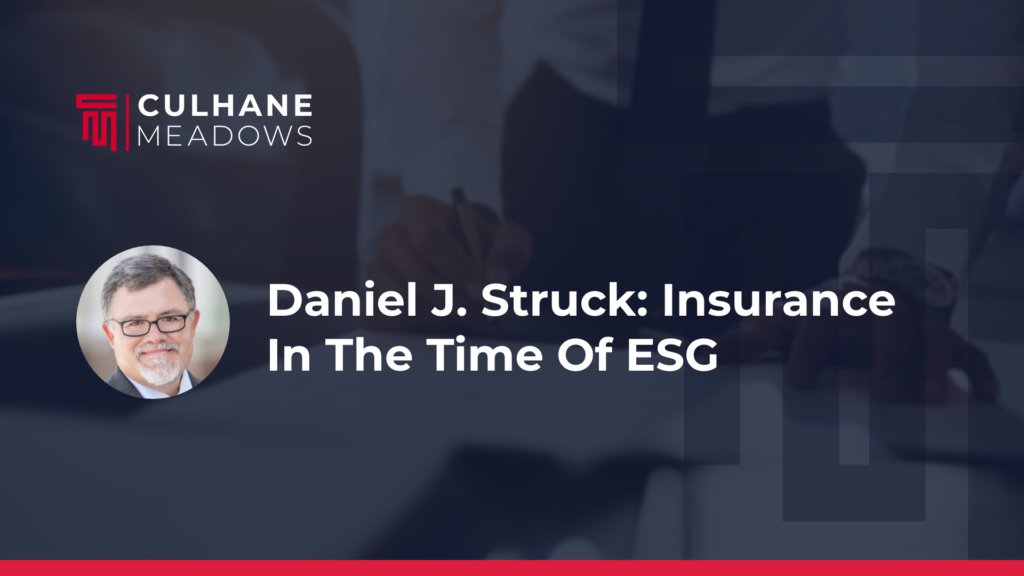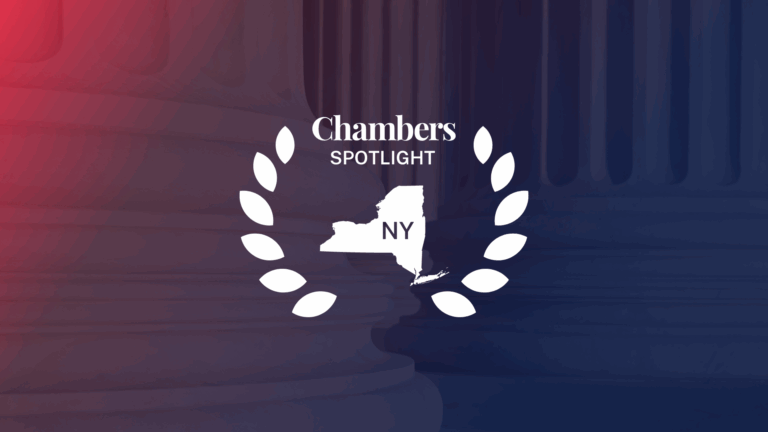Culhane Meadows’ Chicago partner Dan Struck recently authored an article for the latest edition of Board Leadership about how ESG litigation is shaking out and how insurers are responding.
Here are a few excerpts from the article:
In a previous article (What We Talk About When We Talk About ESG) we discussed some of the ambiguities surrounding discussions about ESG. Those ambiguities were centered around questions about the definition and scope of ESG; what makes a corporation successful from an ESG perspective; how material progress toward the achievement of ESG principles is measured; and whether there is any correlation between successful engagement in ESG initiatives and profitability or reduced corporate risk. We also reviewed some of the emerging regulatory and litigation risks associated with ESG. Given the ambiguities and uncertainties that are inherent in any discussion of ESG, even with the best of intentions it may well be impossible to satisfy every regulatory body or interested set of stakeholders. Nonetheless, doing nothing is not a viable option for business leaders and directors: ignoring stakeholders, investors, and regulators who urge that corporations engage in ESG initiatives is itself a way of taking a position concerning ESG programs and opens a corporation to a particular category of potential regulatory scrutiny and stakeholder claims.
…
In the Labyrinth of Insurance
Litigation and regulatory investigations arising from or concerning ESG-related issues have the potential to involve multiple categories of commercial insurance coverage. The type of injury alleged, whether the allegations against an insured are brought in a litigation or a formal regulatory proceeding, the nature of the conduct that is alleged to have caused an injury, the nature of the relief sought, and the identity of the alleged perpetrator of an alleged injury are all relevant to identifying the potentially applicable insurance coverage. Potentially relevant categories of coverage include the following:
Directors and Officers Insurance: In the most general of terms, D&O insurance provides coverage for claims against insured persons and the insured business alleging that some wrongful act (an error or omission that constitutes a breach of duty) resulting in an injury was committed in the course of managing the business. These policies typically provide coverage for claims brought against individual insured persons in their insured capacity if they are not indemnified by the insured business, claims brought against insured persons in their insured capacity if they are indemnified by the insured business, and claims brought against the insured business. For public companies, the business itself is covered only for claims involving company securities—such as shareholder derivative actions, securities litigation, and securities-related investigations.
…
Errors & Omissions/Professional Liability Insurance: To oversimplify, this broad category of insurance policies provides coverage for claims against insured persons and an insured business alleging that some wrongful act (an error or omission that constitutes a breach of some particular duty or standard of care) committed while acting in an insured capacity that resulted in an injury. This category of insurance coverage includes more than policies directed to specific professions such as lawyers, medical practitioners, engineers, and architects. E&O coverage is also written for business activities that require a particular standard of care such as banking, fund management, investment advice, and technology services. E&O policies contain exclusions and limitations on coverage similar to the corresponding exclusions and limitations in D&O insurance policies: crime and fraud, conduct outside an insured’s capacity as an insured, prior claims, and prior knowledge.
Fiduciary Liability: This is a specialized category of E&O insurance applying to claims for alleged breaches of duty against insureds acting in a fiduciary capacity. Although certainly not limited to such, fiduciary liability insurance is typically thought of as covering the managers of pension and benefit plans in ERISA claim. The exclusions and limitations pertinent to fiduciary liability insurance policies are consistent with the general contours of the exclusions and limitations discussed above.
Employment Practices Liability: This category of commercial insurance coverage applies to claims for alleged wrongful acts in connection with employment practices. This type of coverage applies to claims for discrimination based on membership in a protected class or other improper employment-related policies. This type of policy typically covers claims brought by current and former employees as well as claims brought by employment applicants. This category of insurance policies may not provide coverage or may only provide limited coverage for wage and hour claims or claims involving errors in calculating pay or benefits.
General Liability: Commercial general liability (CGL) insurance covers an insured for claims brought by third parties for bodily injury, personal injury, and property damage. These policies are largely written on an “occurrence” basis, which means that coverage can reach back to policies that were in effect when the event that allegedly resulted in the relevant bodily injury or property damage to place. In the case of claims involving property damage or bodily injury alleged caused by emissions or toxic materials, it is possible that responsive coverage may reach back decades.
…
Other Specialized Insurance: Under the correct circumstances, it is possible that additional types of commercial insurance coverage may respond to ESG-related litigation or involve issues pertinent to ESG priorities. Among the potentially relevant categories of coverage are kidnap and ransom (which generally covers losses resulting from adverse events involving executives traveling abroad), media liability (covers claims for personal injuries including invasions of privacy and libel and slander for media companies subject to industry limitations under CGL coverage), and cyber risk (covers a mix of first-party loss and third-party liability coverage that may include technology professional liability, data and privacy liability, and data breach response costs).
This list of potentially responsible categories of insurance coverage is wide-ranging. This is because of the still-developing risks of liability that might result from ESG initiatives. Just as the concept of ESG encompasses an extremely broad, ambiguous, imprecisely defined cloud of environmental, social, and governance issues, the types of claims that can arise out of ESG efforts are similarly broad. Given the breadth of potential exposures, it will be important for businesses to survey their entire insurance portfolio when faced with ESG-related litigation.
Chronicle of Coverage Disputes Foretold
There are recurring patterns of facts and circumstances that give rise to ESG regulatory scrutiny and litigation. Given the challenges related to identifying ESG priorities, carrying out those priorities, and resolving the tensions between competing interests, there are a number of identifiable issues around which the challenges in instituting and managing a successful ESG program tend to coalesce. These recurring issues tend to result in particular kinds of ESG-related claims. We will attempt to identify some of the recurring issues that arise in relation to ESG programs and the types of claims that are associated with those issues and then attempt to map those claim types against the categories of insurance coverage that might respond to those claim types.
Nature of the Substantive ESG Goals: The breadth and diversity of issues that can be characterized as ESG priorities present a host of pitfalls for corporate boards trying to determine how to respond effectively to the call for greater ESG compliance. There is something to offend everyone in the bundle of environmental, social, and governance priorities that are grouped together in the ESG basket. Virtually no two lists of ESG concerns or priorities are identical. Some of the issues identified as ESG priorities are susceptible to wildly divergent interpretations. Indeed, favoring one ESG goal (e.g., phasing out of fossil fuels) may impair another ESG goal (encouraging economic development in poor but resource-rich nations).
…
Disagreements about the identification of particular substantive ESG goals may take the form of so-called ESG backlash. Some of the more high-profile examples of backlash take the form of legislation or executive action expressing disapproval of making corporate decisions based on ESG criteria or pulling state or local investment or pension funds from fund managers that apply ESG considerations in making investment decisions. Even if these actions cause damage to a corporation, these are not claims or loss events that are likely to implicate commercial insurance.
However, disagreements about the identification of particular substantive ESG goals may also take the form of litigation by dissatisfied shareholders or fund beneficiaries. Mere dissatisfaction with a corporation’s ESG priorities does not necessarily provide a justiciable basis for a shareholder claim or—in the case of a pension beneficiary—a viable ERISA claim. The solution to unhappiness with a corporation’s prioritization of particular ESG goals is to invest with another corporation or fund manager or to move one’s business elsewhere. To maintain a viable claim expressing disagreement with a corporation’s selection of ESG goals, it is necessary to point to some resulting injury, most likely in the form of a drop in stock price or the frustration of some corporate purpose.
…
As with any claim triggering D&O, fiduciary, E&O, or EPLI insurance coverage, depending on the particular facts and circumstances, the conduct and prior knowledge groups of exclusions may be relevant. If ESG-related litigation becomes commonplace, there also is a possibility that new exclusions specific to particular subject matters for claims may be introduced.
Commitment to ESG Goals: In a related vein, it is almost never possible to “accomplish” or “achieve” ESG. There are some ESG priorities that can be expressed in terms of a fixed benchmark, such as reducing emissions or becoming carbon neutral by some fixed date. Of course, setting a fixed goal is not the same thing as achieving that goal. A corporate promise to pursue an ESG goal is empty if there is no commitment to that goal.
…
Good Faith in Setting and Performing the ESG Goals: Related closely to the preceding discussion of commitment to an ESG goal, a key factor in predicting the likelihood that a corporate ESG program will be subject to scrutiny is the intent of a corporation in setting an ESG goal. If an enterprise’s ESG goals are announced merely for the sake of positive publicity or inducing investment and there is no intent to institute practices in furtherance of those goals, regulatory scrutiny and litigation become much more likely. Material misrepresentations, whether they are about ESG goals or financial performance, will always be a source of claims against a corporation.
…
The Economic Impact of ESG Goals: Because we are discussing ESG priorities in a commercial context, either in connection with corporations setting environmental-, social-, or governance-related operational priorities and goals, or investment vehicles establishing environmental-, social-, or governance-related standards for investment decisions, the economic impact of ESG practices is a significant factor in assessing the risk associated with a particular set of ESG goals.
…
Balancing Duties to Stakeholders and ESG Goals: Advocates of ESG initiatives often claim that enterprises that are committed to ESG practices are a good investment, have responsible management, and behave in a responsible manner that reduces corporate risk. The argument assumes that being a responsible corporate citizen by supporting and acting consistently with some set of environmental, social, and governance principles is an indicator of responsible and capable management. However, to some shareholders, fund beneficiaries, investors, and other stakeholders, the primary hallmark of responsible management is acting in the interests of stakeholders. ESG may be a nice feel-good activity, but the interest of many stakeholders is the return on investment.
…
Wait and See
It is impossible to know if ESG initiatives will result in a substantial wave of litigation. Certainly, ESG initiatives pose substantial performance challenges for corporate insureds. ESG initiatives should not be launched solely for the sake of doing something. The assumption that companies that are launching ESG initiatives are good risks assumes that the corporate embrace of ESG is an indicator of corporate success and reduced liability and regulatory risk. Ultimately, that assumption may yet prove to be accurate. But ESG initiatives also may prove to be a magnet for litigation due to controversial choices or unmet goals. The failure to follow through on ESG goals or the inadequate commitment to stated goals are invitations to regulatory scrutiny and stakeholder litigation.
…
The process of making ESG decisions, the complexity of evaluating the level of commitment to ESG initiatives, and the risks that are associated with ESG initiatives may be more challenging and nuanced than often is assumed. A clear-eyed approach and careful analysis in adopting appropriate ESG goals, as well the commitment to fulfill stated goals, are the bare minimum of a successful ESG program. There is no guarantee that there will be immediate payoffs or that realistic accomplishments will be viewed favorably by analysists or the investment market. If there is a payoff to ESG initiatives, it most likely will come in the form of leaving an entity better prepared to meet future challenges as the byproduct of careful planning and the commitment to continual improvement. In other words, an ESG-friendly culture is not much different than the kind of corporate culture that responsible and healthy boards always have fostered. It may be difficult to define or measure ESG precisely. The definitional and methodological sloppiness associated with much of the current discussion is unfortunate, but a board that is prepared to adopt to ESG demands is one that is prepared for the vicissitudes and changing circumstances that face any business enterprise.
Read the entire article HERE.
About Culhane Meadows – Big Law for the New Economy®
The largest woman-owned national full-service business law firm in the U.S., Culhane Meadows fields over 70 partners in eleven major markets across the country. Uniquely structured, the firm’s Disruptive Law® business model gives attorneys greater work-life flexibility while delivering outstanding, partner-level legal services to major corporations and emerging companies across industry sectors more efficiently and cost-effectively than conventional law firms. Clients enjoy exceptional and highly-efficient legal services provided exclusively by partner-level attorneys with significant experience and training from large law firms or in-house legal departments of respected corporations. U.S. News & World Report has named Culhane Meadows among the country’s “Best Law Firms” in its 2014 through 2023 rankings and many of the firm’s partners are regularly recognized in Chambers, Super Lawyers, Best Lawyers and Martindale-Hubbell Peer Reviews.
The foregoing content is for informational purposes only and should not be relied upon as legal advice. Federal, state, and local laws can change rapidly and, therefore, this content may become obsolete or outdated. Please consult with an attorney of your choice to ensure you obtain the most current and accurate counsel about your particular situation.






